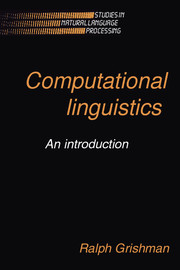1 - What is computational linguistics?
Published online by Cambridge University Press: 05 June 2012
Summary
The objectives of computational linguistics
Computational linguistics is the study of computer systems for understanding and generating natural language. In this volume we shall be particularly interested in the structure of such systems, and the design of algorithms for the various components of such systems.
Why should we be interested in such systems? Although the objectives of research in computational linguistics are widely varied, a primary motivation has always been the development of specific practical systems which involve natural language. Three classes of applications which have been central in the development of computational linguistics are
Machine translation. Work on machine translation began in the late 1950s with high hopes and little realization of the difficulties involved. Problems in machine translation stimulated work in both linguistics and computational linguistics, including some of the earliest parsers. Extensive work was done in the early 1960s, but a lack of success, and in particular a realization that fully-automatic high-quality translation would not be possible without fundamental work on text ‘understanding’, led to a cutback in funding. Only a few of the current projects in computational linguistics in the United States are addressed toward machine translation, although there are substantial projects in Europe and Japan (Slocum 1984, 1985; Tucker 1984).
Information retrieval. Because so much of the information we use appears in natural language form – books, journals, reports another application in which interest developed was automatic information retrieval from natural language texts. […]
- Type
- Chapter
- Information
- Computational LinguisticsAn Introduction, pp. 4 - 9Publisher: Cambridge University PressPrint publication year: 1986



